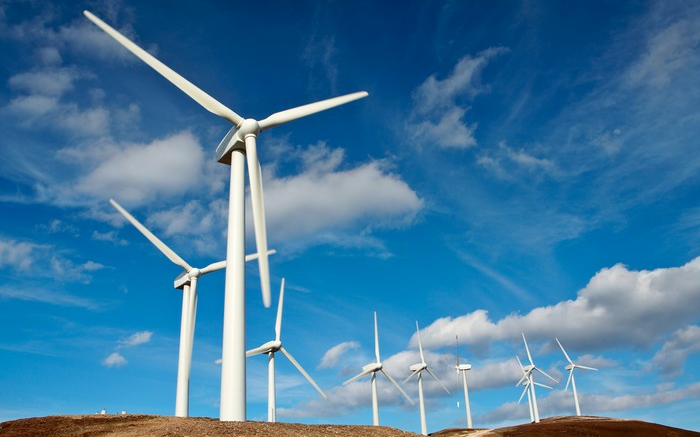As the world increasingly replaces fossil fuels with renewables to cut both greenhouse gas emissions and energy costs, plenty of savvy investors are looking to cash in on the clean energy growth story.
In a recently released report titled Renewables 2019, the International Energy Agency projected that global renewable power capacity will grow by a staggering 50% between 2019 and 2024, led by solar photovoltaics, which are expected to account for 60% of that growth. On the demand side, renewable energy sources are forecast to generate 30% of total worldwide power by 2024, up from 26% currently. That humongous potential provides some compelling opportunities for investors.
You’re unlikely to go wrong if you look for companies that are making conscious efforts to expand their clean energy footprints while remaining committed to shareholders. With those criteria in mind, I believe NextEra Energy (NYSE:NEE) and Brookfield Renewable Partners (NYSE:BEP) are among the top renewable energy stocks you can buy in January.
Invest in the wind and solar leader
NextEra Energy is one of the best ways to play renewable energy given its solid foothold in the industry, massive expansion plans, growth goals, and dividend track record.

Image source: Getty Images.
The company has come a long way since its first wind farm began producing electricity in 1998: Today, NextEra is the world’s largest producer of wind and solar energy, thanks to its decisions to invest in them long before most other traditional utilities took the plunge. In 2014, the company even launched a limited partnership, NextEra Energy Partners, to acquire and manage clean energy projects.
NextEra Energy operates two broad businesses: electric utilities Florida Power & Light (FPL) and Gulf Power Company, which together serve more than 5 million customers in Florida; and NextEra Energy Resources, its renewable energy arm.
From 2019 through 2021, NextEra expects to grow its adjusted earnings per share (GAAP EPS adjusted for one-time items) at an annualized rate of 6% to 8% from a 2018 earnings base of $7.70. If management can hit those goals — underpinned by its regulated electricity business and a whopping $50 billion to $55 billion in planned capital investments — the company’s adjusted earnings could hit $10 a share by 2022.
The company plans to invest in transmission and distribution storm hardening (to better protect grids in hurricane-prone Florida), building smart grids, repowering wind farms, and expanding its solar, wind, and energy-storage asset base.

Image source: NextEra Energy’s November 2019 presentation at the Edison Electric Institute Conference Orlando, Florida.
Given NexEra’s performance history, patient shareholders can trust management and expect to reap rich rewards in the long run, not only in the form of a greater share in the company’s growing earnings base but also in dividends. If management meets its goals, it could easily afford to hike its payout by double-digit percentages every year in the near future at least.
In the coming weeks, I expect NextEra to announce its dividend policy and projections beyond 2020, likely along with its full-year 2019 numbers. Considering how high the expectations are for this renewable energy leader, scooping up some of its 2%-yielding shares now would be a good idea.
Don’t underestimate hydropower
You might be surprised to know that hydropower, not solar or wind, is currently the world’s largest renewable source of electricity generation. And Brookfield Renewable Partners is the perfect bet on hydroelectric power — that source provides nearly 74% of the total power generated by the company. Wind comprises 22% and solar the rest.
Brookfield has a strong global footprint, with assets spread across 15 countries in North America, Latin America, Europe, and Asia. The International Energy Agency’s projection of 9% growth in hydropower capacity through 2024 led by China, India, and Brazil particularly bodes well for Brookfield given that it counts all three nations among its “core” markets.

Image source: Getty Images.
Though Brookfield has high leverage, it doesn’t have any material debt maturing before 2024. That comfortable debt profile, coupled with the backing of parent Brookfield Asset Management, provides it the necessary leeway to raise funds for new projects. For now, the company plans to raise $4 billion for investment over the next five years, $1.5 billion of which is expected to come from asset sales. Brookfield typically sells mature assets and reinvests the proceeds into assets with the potential to generate meaningful cash flows.
During its third-quarter earnings call conference, management confirmed its long-term objective of delivering per unit total returns of 12% to 15% annually to shareholders, driven primarily by development and repowering projects alongside contracted cash flows (almost 89% of its cash flows today originate under long-term contracts) and cost-reduction efforts. Those projected total returns include annual dividend growth of 5% to 9%. With a payout that is now yielding 4.5%, that makes Brookfield one of the best renewable energy stocks to buy and own for the long term.


Be the first to comment on "2 Top Renewable Energy Stocks to Buy in January – Motley Fool"